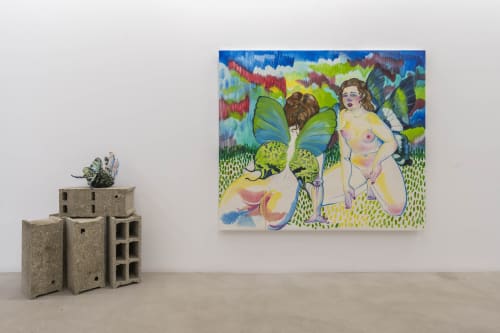The Roman poet Catullus wrote the line "fulsere quondam candidi tibi soles" (once, white suns shone for you), to express, although still very young, his despair due to a fallen love. With as much mischief as understanding, and above all a passion for ancient poetry, the just as young artist Margaux Laurens-Neel seizes on this lyricism to invent her own lost paradise, a lustrous pastel Eden.
She conjures up Ovid's Metamorphoses, the ballet Giselle, and characters straight out of her imagination, where women are imposing, men decorative and animals wild. In fact, it would be no lie to say that the female body in Western painting, done by men, has suffered all too much from a high degree of decorativeness. The artist has therefore chosen, with great tenderness and an even greater sense of humour, to reserve this fate for male models in her practice. Without theorising, she offers a view - not a new one, but one that is not yet consensual - of the strength of the female body and the grace of the male body.
So there's no question of obscenity here, but purely artistic desire, a desire to represent, also and as a woman, other women's bodies, but also organs usually associated with performance, violence or coarseness. We see them everywhere on our city walls, drawn by people we wouldn't call aesthetes, but shouldn't an artist have the right to embellish them with as much irony as sincerity? Try looking at these sculptures, for example, as purely decorative objects: it's an act that's meant to be funny and affectionate. Gustave Courbet painted The Origin of the World to satisfy a collector with very specific tastes, and Margaux Laurens-Neel puts belt buckles and nipples wherever she wants, because she thinks it's beautiful and she's mastered the art of their representation.
With her classical touch, and the heritage she has built up thanks to Pierre Paul Rubens, Suzanne Valadon and Félicien Rops, Margaux Laurens-Neel paints and models bodies and flowers that form an ode to love and senses. The artist depicts giants whose eyebrows look like sprigs of fresh grass, and the grass
they trample and tread on resembles hair, fur and fleece. The skins and elements blend harmoniously, and that's only natural. The ceramics, sometimes reminiscent of the exuberance of Bernard Palissy, respond to the imposing canvases and wallpaper that blossom for the occasion. The latter, in its full bloom, envelops our gaze, inviting us to contemplate the simple, tranquil beauty of a thousand voluptuous details.
Margaux Laurens-Neel (*1997, FR) lives and works between Paris and Asnières-sur-Seine. She graduated from the Beaux-arts de Paris in June 2021, in the studios of Joann Sfar, Éric Poitevin and Claude Dumas.


